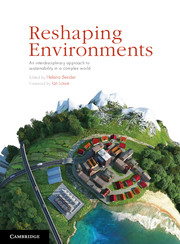Book contents
- Frontmatter
- Contents
- Contributors
- Acknowledgements
- Introduction Reshaping environments – an opportunity for envisioning the future
- Part 1 Cases
- Part 2 Skills
- Part 3 Theory
- 13 Conceptualising change
- 14 Sustainability
- 15 Human needs and norms
- 16 Conceptualising and thinking about environmental systems
- 17 Why scale matters
- Index
- Plate Section
- References
13 - Conceptualising change
Complexity, post-normal science, uncertainty and risk
from Part 3 - Theory
Published online by Cambridge University Press: 05 February 2013
- Frontmatter
- Contents
- Contributors
- Acknowledgements
- Introduction Reshaping environments – an opportunity for envisioning the future
- Part 1 Cases
- Part 2 Skills
- Part 3 Theory
- 13 Conceptualising change
- 14 Sustainability
- 15 Human needs and norms
- 16 Conceptualising and thinking about environmental systems
- 17 Why scale matters
- Index
- Plate Section
- References
Summary
Introduction
This is the first of the theory chapters in the textbook and it covers a range of big ideas. These big ideas have featured in the case studies. Theory is strongly linked to practice, and there is a ‘chicken and egg’ dilemma in knowing whether theory precedes practice or practice creates theoretical understanding. In this book the authors emphasise the strong link between practice and theory. Therefore, this chapter describes theoretical ideas as they are used by practitioners in real-life decision-making situations.
Several assumptions underpin the chapter and the book. The most important one to begin with is to conceive of everything on Earth and in the galaxies surrounding it as part of the same system or multiple systems depending on how these are defined. In Chapters 14 and 16 on sustainability and systems, respectively, there is a discussion of what it means to be part of a system; and the authors of this text consider that systems thinking leads to interlinked ways of thinking and doing, defining and solving problems. The second assumption in this chapter is that the elements within any system, however it is defined, affect all other elements or parts of that system. This interconnectedness is complex because, as is discussed further in this book, interconnectedness may be obvious or it may be obscure. It may be immediately clear that there is an interaction between parts of the system. If a car is defined as a system, then the starting of the motor causes various mechanical parts to interact and these can be both heard and seen depending on the viewer’s vantage point. However, there are also times when the interconnectedness in a system is not so clear. In some regional areas of Australia, this has been the case where there has been a slow rise of salt across a watershed or catchment. This is accompanied by a rising water table. The salt and the water table are underground and not immediately visible to someone passing by. The gradual increase in salt in the upper surface of the soil (where it will affect plant roots) is a situation that can develop undetected and be observed only over many years (Stone 1994). The gradual salinity increase within the soil builds up until the soil is too salty to grow most crops.
- Type
- Chapter
- Information
- Reshaping EnvironmentsAn Interdisciplinary Approach to Sustainability in a Complex World, pp. 277 - 304Publisher: Cambridge University PressPrint publication year: 2012
References
- 1
- Cited by



